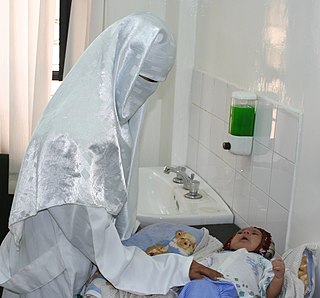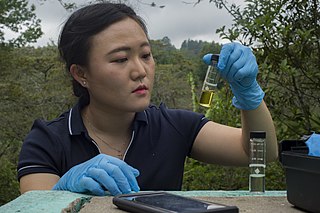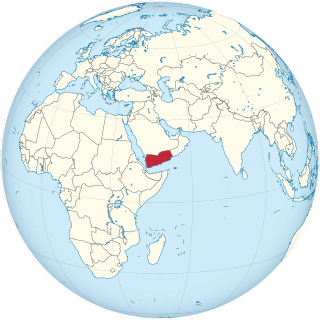Related Research Articles

Cholera is an infection of the small intestine by some strains of the bacterium Vibrio cholerae. Symptoms may range from none, to mild, to severe. The classic symptom is large amounts of watery diarrhea lasting a few days. Vomiting and muscle cramps may also occur. Diarrhea can be so severe that it leads within hours to severe dehydration and electrolyte imbalance. This may result in sunken eyes, cold skin, decreased skin elasticity, and wrinkling of the hands and feet. Dehydration can cause the skin to turn bluish. Symptoms start two hours to five days after exposure.

Legionella is a genus of pathogenic gram-negative bacteria that includes the species L. pneumophila, causing legionellosis including a pneumonia-type illness called Legionnaires' disease and a mild flu-like illness called Pontiac fever.

Drinking water or potable water is water that is safe for ingestion, either when drunk directly in liquid form or consumed indirectly through food preparation. It is often supplied through taps in which case it is also called tap water. Typically in developed countries, tap water meets drinking water quality standards, even though only a small proportion is actually consumed or used in food preparation. Other typical uses for tap water include washing, toilets, and irrigation. Greywater may also be used for toilets or irrigation. Its use for irrigation however may be associated with risks.

Estimates of the casualties from the Iraq War have come in several forms, and those estimates of different types of Iraq War casualties vary greatly.

Water purification is the process of removing undesirable chemicals, biological contaminants, suspended solids, and gases from water. The goal is to produce water that is fit for specific purposes. Most water is purified and disinfected for human consumption, but water purification may also be carried out for a variety of other purposes, including medical, pharmacological, chemical, and industrial applications. The history of water purification includes a wide variety of methods. The methods used include physical processes such as filtration, sedimentation, and distillation; biological processes such as slow sand filters or biologically active carbon; chemical processes such as flocculation and chlorination; and the use of electromagnetic radiation such as ultraviolet light.
Investment in post-2003 Iraq refers to international efforts to rebuild the infrastructure of Iraq since the Iraq War in 2003. Along with the economic reform of Iraq, international projects have been implemented to repair and upgrade Iraqi water and sewage treatment plants, electricity production, hospitals, schools, housing, and transportation systems. Much of the work has been funded by the Iraq Relief and Reconstruction Fund, and the Coalition Provisional Authority.
Chlorine bombings in Iraq began as early as October 2004, when insurgents in Al Anbar province started using chlorine gas in conjunction with conventional vehicle-borne explosive devices.

Despite the significant progress Yemen has made to expand and improve its health care system over the past decade, the system remains severely underdeveloped. Total expenditures on health care in 2002 constituted 3.7 percent of gross domestic product.
Health in Iraq refers to the country's public healthcare system and the overall health of the country's population. Iraq belongs to WHO health region Eastern Mediterranean and classified as upper middle according to World Bank income classification 2013. The state of health in Iraq has fluctuated during its turbulent recent history and specially during the last 4 decade. The country had one of the highest medical standards in the region during the period of 1980s and up until 1991, the annual total health budget was about $450 million in average. The 1991 Gulf War incurred Iraq's major infrastructures a huge damage. This includes health care system, sanitation, transport, water and electricity supplies. UN economic sanctions aggravated the process of deterioration. The annual total health budget for the country, a decade after the sanctions had fallen to $22 million which is barely 5% of what it was in 1980s. During its last decade, the regime of Saddam Hussein cut public health funding by 90 percent, contributing to a substantial deterioration in health care. During that period, maternal mortality increased nearly threefold, and the salaries of medical personnel decreased drastically. Medical facilities, which in 1980 were among the best in the Middle East, deteriorated. Conditions were especially serious in the south, where malnutrition and water-borne diseases became common in the 1990s. Health indicators deteriorated during the 1990s. In the late 1990s, Iraq's infant mortality rates more than doubled. Because treatment and diagnosis of cancer and diabetes decreased in the 1990s, complications and deaths resulting from those diseases increased drastically in the late 1990s and early 2000s.

The seventh cholera pandemic is the seventh major outbreak of cholera and occurred principally from the years 1961 to 1975, but the strain involved persists to the present. WHO and some other authorities believe this should be considered as an ongoing pandemic. As stated in its cholera factsheet dated 30 March 2022, the World Health Organization (WHO) continues to define this outbreak as a current pandemic, and with cholera having become endemic in many countries. In 2017, WHO announced a global strategy aiming to end this pandemic by 2030.

The 2008 Zimbabwean cholera outbreak was an epidemic of cholera affecting much of Zimbabwe from August 2008 until June 2009. The outbreak began in Chitungwiza in Harare Metropolitan Province in August 2008, then spread throughout the country so that by December 2008, cases were being reported in all 10 provinces. In December 2008, The Zimbabwean government declared the outbreak a national emergency and requested international aid. The outbreak peaked in January 2009 with 8,500 cases reported per week. Cholera cases from this outbreak were also reported in neighboring countries South Africa, Malawi, Botswana, Mozambique, and Zambia. With the help of international agencies, the outbreak was controlled, and by July 2009, after no cases had been reported for several weeks, the Zimbabwe Ministry of Health and Child Welfare declared the outbreak over. In total, 98,596 cases of cholera and 4,369 deaths were reported, making this the largest outbreak of cholera ever recorded in Zimbabwe. The large scale and severity of the outbreak has been attributed to poor sanitation, limited access to healthcare, and insufficient healthcare infrastructure throughout Zimbabwe.
The Iraq War resulted in multiple humanitarian crises.

The Iraq War started with a US-led invasion on 20 March 2003, causing much damage to the capital city, Baghdad. The war and collateral damage continued for years.

The 2010s Haiti cholera outbreak was the first modern large-scale outbreak of cholera—a disease once considered beaten back largely due to the invention of modern sanitation. The disease was reintroduced to Haiti in October 2010, not long after the disastrous earthquake earlier that year, and since then cholera has spread across the country and become endemic, causing high levels of both morbidity and mortality. Nearly 800,000 Haitians have been infected by cholera, and more than 9,000 have died, according to the United Nations (UN). Cholera transmission in Haiti today is largely a function of eradication efforts including WASH, education, oral vaccination, and climate variability. Early efforts were made to cover up the source of the epidemic, but thanks largely to the investigations of journalist Jonathan M. Katz and epidemiologist Renaud Piarroux, it is widely believed to be the result of contamination by infected United Nations peacekeepers deployed from Nepal. In terms of total infections, the outbreak has since been surpassed by the war-fueled 2016–2021 Yemen cholera outbreak, although the Haiti outbreak is still one of the most deadly modern outbreaks. After a three-year hiatus, new cholera cases reappeared in October 2022.

Seven cholera pandemics have occurred in the past 200 years, with the first pandemic originating in India in 1817. The seventh cholera pandemic is officially a current pandemic and has been ongoing since 1961, according to a World Health Organization factsheet in March 2022. Additionally, there have been many documented major local cholera outbreaks, such as a 1991–1994 outbreak in South America and, more recently, the 2016–2021 Yemen cholera outbreak.

The history of water supply and sanitation is one of a logistical challenge to provide clean water and sanitation systems since the dawn of civilization. Where water resources, infrastructure or sanitation systems were insufficient, diseases spread and people fell sick or died prematurely.
As of 24 September 2012, a cholera outbreak in Sierra Leone had caused the deaths of 392 people. It was the country's largest outbreak of cholera since first reported in 1970 and the deadliest since the 1994–1995 cholera outbreak. The outbreak has also affected Guinea, which shares a reservoir near the coast. This was the largest cholera outbreak in Africa in 2012.

Water chlorination is the process of adding chlorine or chlorine compounds such as sodium hypochlorite to water. This method is used to kill bacteria, viruses and other microbes in water. In particular, chlorination is used to prevent the spread of waterborne diseases such as cholera, dysentery, and typhoid.

An outbreak of cholera began in Yemen in October 2016. The outbreak peaked in 2017 with over 2,000 reported deaths in that year alone. In 2017 and 2019, war-torn Yemen accounted for 84% and 93% of all cholera cases in the world, with children constituting the majority of reported cases. As of November 2021, there have been more than 2.5 million cases reported, and more than 4,000 people have died in the Yemen cholera outbreak, which the United Nations deemed the worst humanitarian crisis in the world at that time. However, the outbreak has substantially decreased by 2021, with a successful vaccination program implemented and only 5,676 suspected cases with two deaths reported between January 1 and March 6 of 2021.

In October 2022, an outbreak of cholera began in Lebanon. It is likely the result of a serious outbreak in neighboring Syria, which is itself traced back to contaminated water in the Euphrates.
References
- ↑ "Cholera". World Health Organization. Retrieved 5 October 2022.
- ↑ "Water under Siege". Center for Economic and Social Rights. 8 April 2003. Retrieved 5 October 2022.
- ↑ Ahtisaari, Matti. "Report to the Secretary General on Humanitarian Needs in Kuwait and Iraq" (PDF). The United Nations. Retrieved 5 October 2022.
- ↑ "Water- Iraq: Emergency". World Bank. Retrieved 6 October 2022.
- ↑ Karouny, Mariam (8 February 2007). "Iraq's deputy health minister arrested". Reuters.
- ↑ "U.N. reports cholera outbreak in northern Iraq". CNN. 30 August 2007. Retrieved 30 August 2007.
- ↑ "Cholera in Iraq". WHO. 10 September 2008. Archived from the original on 3 October 2014. Retrieved 22 October 2017.
- ↑ "Cholera in Iraq- Update 2". World Health Organization. Retrieved 6 October 2022.
- ↑ Glanz, James; Grady, Denise (12 September 2007). "Cholera Epidemic Infects 7,000 in Iraq". The New York Times. Retrieved 5 October 2022.
- ↑ Kramer, Andrew E. (21 September 2007). "Cases of Cholera Reach Baghdad". The New York Times. Retrieved 26 September 2007.